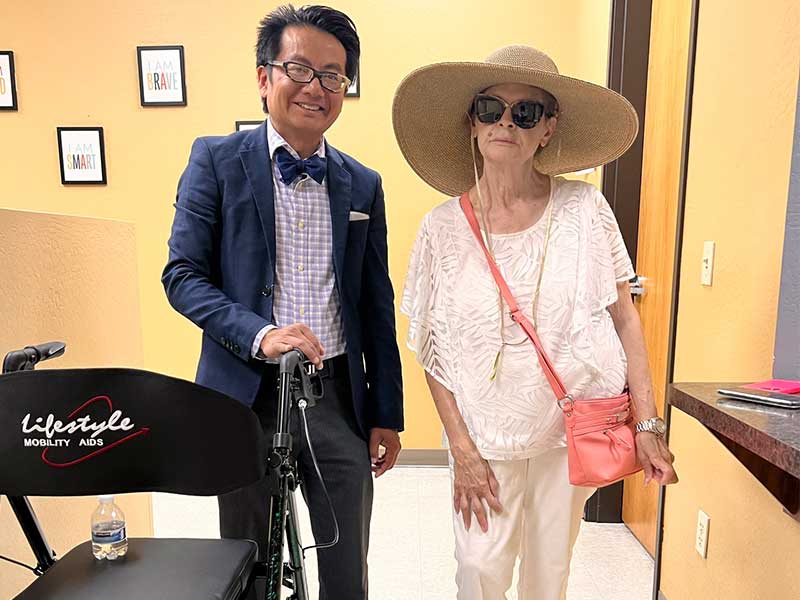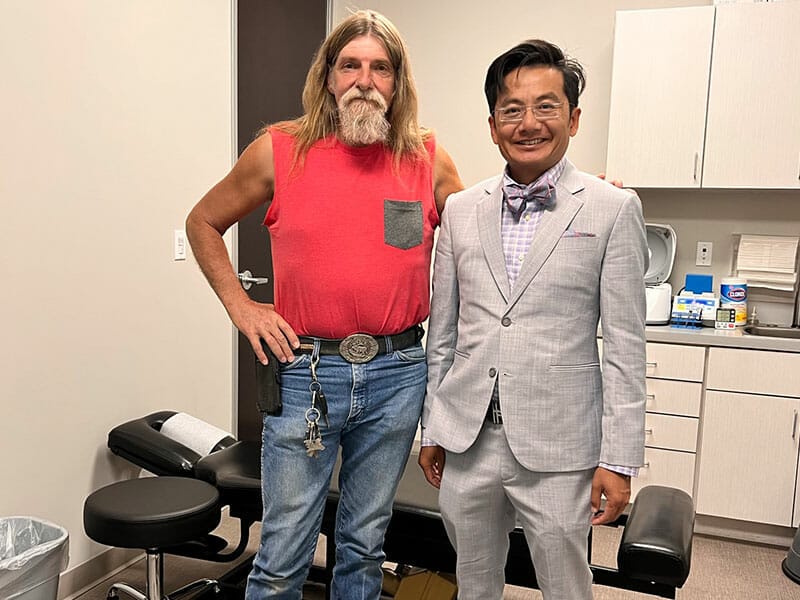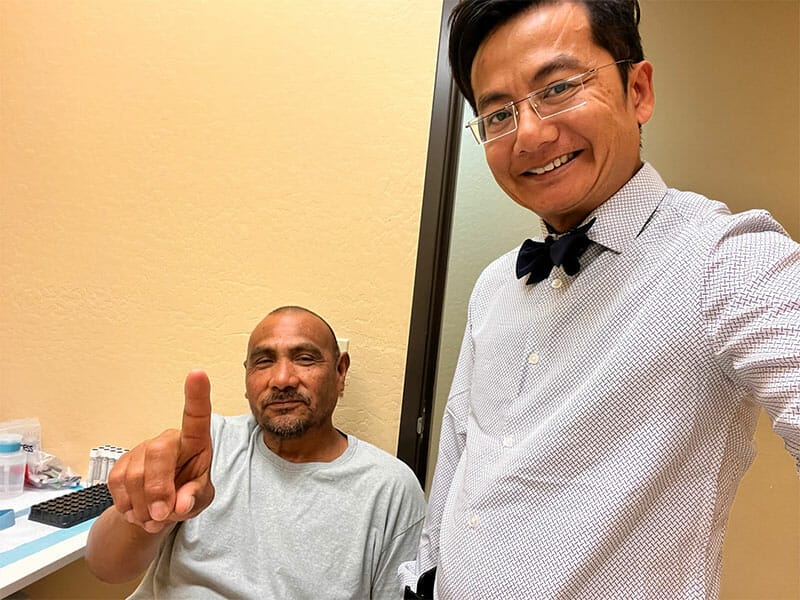Platelet Rich Fibrin
We have pioneered a novel injection technique to resolve pain using platelets from the patient’s own blood to provoke an immune response to stimulate self-healing.
Surprisingly, this technique works without any additional drug or chemical added.
A true natural product created from the patient’s own body to create a long lasting resolution of pain…and most of the time a permanent cure of pain…until you have a new injury.
Before we describe our technique to resolve pain, it is important to explain our philosophy about pain because it directly impacts the choices we make to resolve your pain.
We have developed a Grand Unifying Theory about Pain and it revolves around 3 principles.
Principle number 1: All body parts have the capability to self-heal pain within 3 months.
We have chosen 3 months as a benchmark because there are several self-explanatory examples of self-healing.
For example, a cut in the skin is healed by the immune system within a few weeks. A broken bone is healed by the immune system within 1-2 months. If you have major surgery like open heart surgery, abdominal surgery, spine surgery, etc…all those body parts that got cut are mended together by the immune system within 2-3 months.
If you can heal a cut in your skin, your immune system is intact and has the capability to fully heal pain in any body part.
Principle number 2: Any pain that lasts longer than 3 months is a failure of the immune response.
It is the immune system that fixes everything. It is the immune system that heals the cut in the skin, fixes the broken bone, and mends the parts cut in surgery.
Just like cancer is a failure of the immune response. It is widely acknowledged that if the immune system recognized the bad cancer cells, then the cancer would be cured from the body in a matter of weeks.
Therefore, if the pain lasts longer than 3 months in the body, it is because the immune system failed to recognize the source of the pain.
Thus the solution to any pain is to provoke the immune system to recognize the source of the pain which will then lead to self-healing.
In other words, the healing process is stuck and we need to “unstuck” the process with the immune system.
Principle number 3: the pain source is likely one singular pinpoint spot rather than an area.
Therefore if an injection is required, only one site should only be injected, rather than trying to inject multiple sites within an area.
Furthermore, the size of the pain source is smaller than 1cm and likely very small of only a few millimeters in diameter.
An injection that is several centimeters or an inch away from the source of the pain will likely not work well.
Thus it is very important to identify and correctly localize the true source of the pain because being “close” is not sufficient.
The pain source for most neck and lower back pain is NOT the internal disc that is herniated but almost always the outside facet.
The pain source for most joint pain like the knees, ankles, elbows, wrist is NOT the inside of the joint but almost always the outside at the insertion point of the tendon into the bone.
The exception is the shoulder where the pain is almost always inside the joint.
Combining all 3 principles: The solution to chronic pain is to first recognize when healing has stalled after 2-3 months.
Secondly, one must identify the correct source of the pain to a pinpoint accuracy.
Thirdly, one must utilize techniques that provoke the immune response to promote natural healing.
In contrast, current medical standards of care utilize medications that block the immune response such as steroids/NSAIDs.
These medications inhibit natural healing and should be avoided.
Before we discuss the 2 ways that we have discovered that provoke the immune response, it is instructive to talk about some common procedures that medical doctors perform that in our opinion don’t work as well because those techniques do not provoke the immune response for self-healing.
The most common pain procedure that medical doctors perform is a cortisone/steroid Epidural injection where a needle is inserted into the epidural space, which is a potential space outside of the dura sac containing the spinal cord.
A cortisone/steroid medication is injected into the epidural space several spine levels below the targeted disc due to anatomical limitations of an entry point.
The medication will migrate upward to the affected disc with the intent to reduce the swelling of the herniation that is thought to be pushing on the nerve and therefore causing the pain.
The 1st problem with the epidural injection technique is that medication cortisone/steroid is used.
Cortisone/Steroid medication works by telling the immune system to “go away” which leads to a temporary reduction in inflammation and therefore a temporary reduction in pain.
If you tell the immune system to “go away” then there is nothing left behind to fix the original injury because it is the immune system that fixes everything.
Often times, the pain returns because the original injury has not been repaired because the cortisone/steroid has blocked the immune response.
The 2nd problem with the epidural injection is that the main source of the pain is likely NOT the deeper herniated disc inside the spinal column.
In our experience, the source of the pain is 95% of the time originating from outside of the spinal column in the ‘Facet Joint’ which is the connection between the bones of the spine.
These facet joints allow the spine to bend and twist.
We can prove the outside Facet joint is the source of the pain because we can push on it directly on your spine and it hurts. You cannot push on the deeper herniated disc because the spine bone is in the way.
Thus the most common source of the pain of the spine is the outside Facet joint and is less commonly caused by the deeper inside herniated disc.
Injecting into the epidural space is too deep and bypasses the outside Facet joint.
The exception to this rule is when the herniated disc is large enough to cause nerve compression wherein you see the trifecta of both numbness + muscle weakness + pain.
It would be highly unusual to have only pain but without numbness or weakness because the nerves for both sensation and strength are usually affected together.
Another common procedure doctors perform is a cortisone/steroid Facet joint injection.
We believe this is the correct location of the source of the pain because the facet joint is the pivot point of spine movement. However the cortisone/steroid is the wrong medication to use. Cortisone/steroid medications tells the immune system to “go away” therefore causing a temporary reduction in pain. The pain often comes back after a few months because the immune system was prevented from being able to fix the problem.
Conversely, our technique to resolve pain relies upon the opposite approach of cortisone/steroid theory wherein we want more of the immune system to come to the source of the pain.
If the immune system recognized the source of the pain, it would then fix it.
Another common procedure doctors perform is Radio Frequency Ablation or RFA wherein a probe is inserted next to the facet and the probe is heated to “burn off the nerves”.
Disabling the pain sensory nerves causes a reduction of pain. However, the pain can come back after a year because the nerves grow back. The pain was not resolved and always present, but one couldn’t feel the pain.
We would suggest the better solution is to provoke the immune response to self-heal the injury to permanently resolve the pain.
The 1st technique we utilize to provoke a small immune response is a technique we have named a “Near-Facet injection”.
We insert a needle into the muscle of the neck or lower back and touch the bone on the outside of the spine near the facet.
The facet is the pivot point of the spine and the source of most people’s spine pain.
The procedure causes pain similar to an injection at the dentist because we use a similar anesthetic called lidocaine to temporarily numb the area for 1-2 hours. Most patients report a significant reduction or resolution of their pain for 1-2 hours if the correct location of the source of pain is chosen.
Thus, the superficial injection of the lidocaine proves that the source of pain is outside of the spine at the pivot point Facet joint rather than a deeper problem like a herniated disc.
The Near-Facet injection allows us to diagnose the source of the pain as well as become a treatment for the pain.
When the needle touches the bone near the Facet, a small injury is created which then provokes an immune response to come heal the needle poke injury as well as hopefully recognize the injury of the Facet nearby and fix the source of pain. This procedure is sufficient for most people to “unstuck” the healing process to resume natural healing.
If 2 near-facet injections are not sufficient to resolve the pain, we move on to the 2nd technique to create a stronger immune response.
The 2nd technique utilizes your own platelets to provoke a very strong immune response to stimulate self-healing.
We utilize the 3rd generation platelet protocol called Platelet Rich Fibrin with Albumin Gel (PRF with Albumin Gel).
If you think about how your body naturally heals after an injury, platelets are almost always involved.
If you get a cut in your skin that causes bleeding, it would be the platelets that stop the bleeding. More importantly, the platelets send out a signal to the body that there is something wrong in the area. The immune system recognizes the distress signal from the platelets and comes to the area to repair the damaged parts.
The same process occurs when you fracture a bone resulting in small amounts of bleeding. The platelets stop the bleeding and send a signal to heal the fractured site.
Major surgery like abdominal surgery or chest surgery have many body parts that bleed. The platelets stop the bleeding and send a signal to mend together all the body parts that were cut.
For chronic pain, we can harness the same platelets to inject into a damaged body part to send the distress signal to provoke natural self-healing.
The platelet mixture we inject into your body is completely natural from your own body with NO chemical additives and always “fresh” as the goal is to draw your blood and separate the platelets so that it is ready for injection within the hour.
The platelet protocol we utilize is the 3rd generation Platelet Rich Fibrin with Albumin Gel (PRF with Albumin Gel) which was first published in 2020.
The 3rd generation platelet protocol is better than the 1st generation Platelet Rich Plasma (PRP) published in the 1980s because no anti-coagulant such as heparin is used.
We want the platelets to stay in place by clotting at the injection site. The anticoagulant in the 1st gen PRP will prevent the platelets from clotting in place and potentially float off elsewhere. The 2nd generation Platelet Rich Fibrin (PRF) published in the 2000s was an improvement because the anticoagulant was taken out which allowed the platelets to clot in place when injected.
However, both 1st gen PRP and 2nd gen PRF have short durations of platelet activity, of approximately 1-3 days before the platelet signal is exhausted (depends on which research article you read).
The 3rd generation PRF with Albumin Gel became a large improvement because the platelet signal is extended to 14 days with the addition of the albumin gel.
The gel is created by heating parts of the yellow serum from the blood containing the albumin protein.
When albumin is heated, the protein expands into a “fluffy” gel which is then combined with the platelets.
The platelet are trapped inside the albumin gel causing the platelets to release their signal slowly over 14 days, thus creating “extended-release” platelets. The lab experiments which showed 14 days of platelet activity mirrors what we see in the clinic with patients.
After a PRF with albumin gel injection, patients state they will have temporary injection site pain for about 1-2 days. Then there will be delayed rise in pain starting on day 3 or 4 which lasts for about 1 week. We interpret the delayed pain to be the immune system recognizing the source of pain and repairing the damaged area.
Most patients state they have healing in week 2 or week 3.
Waiting beyond week 4 does not result in further healing and a repeat injection is performed after 4 weeks if the pain is not fully resolved.
Since the beginning of 2023, our clinic has treated over 150 patients with PRF with albumin gel injections with pain improvement in nearly all patients and a pain resolution in more than 90% of patients.
Most spine pain in the neck and lower back have resolved after 1 injection, with some requiring 2 injections, and a few requiring 3 injections.
Large joints like shoulders require 2 or 3 injections for pain resolution while some are too severe that we are continuing to treat with slight improvements with each injection.
We theorize that the shoulder requires more treatments because the shoulder joint does not have a blood supply inside and therefore take longer to heal.
Many clinics perform platelet injections but we think our clinic has the better protocol for best results with the least number of injections.
Most clinics use the 1st generation PRP which has the anticoagulant preventing clotting and a short duration of platelet activity of 1-3 days.
We use the 3rd generaton PRF with Albumin Gel which has no chemical additives like the anticoagulant. The 3rd generation PRF also has a longer platelet activity of at least 14 days.
Lastly, our injection technique is different because we identify the site of the highest level of pain with pinpoint accuracy and inject in only one location. Injecting many sites or a broad area suggests the injector has not found the source of the pain and is using a scattered gunshot approach to treat the pain.
Below are some examples that illustrate the effectiveness of the 3rd generation platelet injection protocol.

This is an 83 year lady who has severe scoliosis where her back is curved like an ‘S’.
Her shoulders and pelvis are tilted. She cannot stand straight and has to bend one leg to accommodate the tilt. She had severe back pain for decades on many medications.
We were able to mostly resolve her back pain with 3 platelet injections.
We will unlikely resolve all her back pain due to the scoliosis but she is now functional and walks without pain.

This is a 63 year old man who was a pedestrian hit by a vehicle 30 years ago which caused spinal fracture requiring metal rods to fuse and stabilize the lumbar spine.
He came to our clinic limping and could not sit down for the exam because it hurt too much.
We were able to completely 100% resolve his back pain after 2 platelet injections.
He was able to do a knee bend deep squat and able to jump up without any pain.

This is a 40 year old man who stuck his index finger into a garbage disposal work accident one year prior.
He has severe pain to the tip of his finger. He flinched whenever the finger was lightly touched. He was limited in his daily life because he always grabbed objects but without the index finger.
His hypersensitivity to light touch indicated he had nerve damage or neuropathy.
Normally, there is no treatments available for nerve pain besides prescribing nerve pain medications like gabapentin, which don’t work very well.
Surprisingly, 1 platelet injection into the tip of his index finger completely 100% resolved his nerve pain.
He had no pain of the index finger with light touch or heavy pressure.
In summary: the 3rd generation PRF with Albumin Gel is a new technique recently published in the literature in 2020.
Our clinic continues to innovate and optimize the protocol as we discover new ways to utilize the power of our own immune system to provoke natural healing.
Contact Us Today
Give us a text or call:
(602) 632-0000
Business Hours
Mon – Fri: 9:00 am – 5:30 pm
Sat – Sun: Appointment Only
Let's Get Social:
Mesa Clinic
1155 S Country Club Dr.
Mesa, AZ 85210
(Northeast corner Country Club and Southern)
Phoenix Clinic
4338 W Thomas Rd, #117
Phoenix, AZ 85031
(Northwest corner Thomas and 43rd Avenue)



